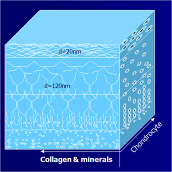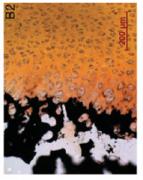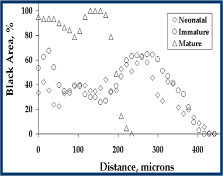ENGINEERING OF SOFT TISSUE-TO-BONE INTERFACESResearch in this area involves generation of tissue-tissue interfaces using functionally graded devices. Demand for the repair or replacement of tissues is increasing at a higher rate, because the clinical success has been strictly restricted by the mismatch in graft-tissue properties and immuno-complications. At this point, interface tissue engineering emerges as a promising approach given the recent developments in the efforts of engineering of very diverse tissues.
Tissue-tissue interfaces are comprised of diverse tissues, and they are not homogeneous yet graded in terms of function, structure and composition (given below is an example of grading in mineral concentration at the ligament-to-bone interface). Therefore, a scaffold/device to be utilized for the engineering of interface tissues should exhibit such structures inherently for the better mimicking of their native counterparts, and design and fabrication of functionally graded materials plays a significant role at this point. |


|
Mineral distribution at the ACL-to-bone interface of immature bovine joint (Wang et al . J Orthop Res 2006) |
|
Schematic of distribution of ECM components at the cartilage-bone interface |

|
Mineral distribution at the ACL-to-bone interface obtained from histology images of Wang et al . J Orthop Res 2006 |

|
Cevat Erisken, Ph.D. |
|
TOBB University of Economics and Technology, Biomedical Engineering Department |
|
TOBB University of Economics and Technology |


